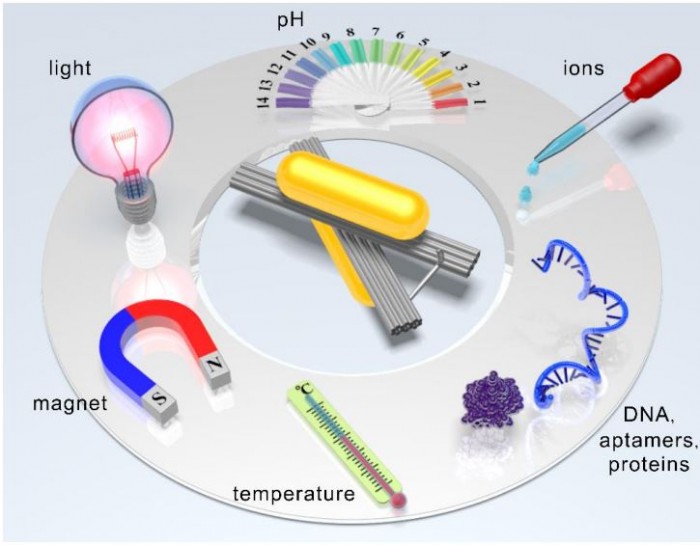DNA could arrange nanoparticles into materials that manipulate light in new ways
When a long strand of DNA is mixed with shorter strands designed to latch on to the longer piece at specific locations, these shorter strands can act like connecting struts linking parts of the longer strand together, forcing it to self-assemble into a three-dimensional shape.
Biochemists have used this “DNA origami” to create complex shapes, including cubes, smiley faces, and even rough maps of China and the Americas.
But this is just the beginning. DNA origami has the potential to make a wide range of devices on the molecular scale. Biochemists have begun to play with artificial enzymes, drug delivery systems, and perhaps even nanobots that can explore the body.

Physicists, too, have begun to explore the technology’s potential. Today, Chao Zhou at the Max Planck Institute for Intelligent Systems in in Germany and a couple of colleagues review the way DNA origami can create exotic metamaterials that manipulate light in ways not possible with conventional materials. They also show how to make shape-changing DNA structures that can act as switches and can even “walk” across surfaces.
In recent years, physicists have begun to study in detail the way photons interact with the sea of electrons in metal conductors. Photons that smash into this “plasmonic” ocean create waves on its surface, like an asteroid impact in Earth’s oceans.
These waves carry information that can be manipulated in various ways. As well as absorbing light, the plasmonic ocean can scatter it and transfer information into it.
So it’s not hard to see why “plasmonics” is an exciting emerging discipline for information processing and communication. But it is still in its infancy because of a number of challenges, not least of which is the nanometer scale on which it occurs. Creating and manipulating metal structures on this scale is hard.
Which is where DNA origami comes into play. The idea is to attach metal nanoparticles or nanorods to a DNA strand and then assemble it into a specific shape that anchors the nanoparticles in place.
Various groups including Zhou and co have done this using gold nanoparticles and nanorods fixed to DNA tubes to create helical structures. They then roll these tubes into rings.
Because the helices can be right-handed or left-handed, they interact with circularly polarized light in different ways. And that provides a way to selectively interrogate them.
These rings have very specific optical properties, such as the ability to interact with light polarized in one direction or another. What’s more, small changes in their shape can dramatically change these properties, because they force the nanoparticles closer together or further apart.
With many of the molecules in solution, the team can monitor these changes by analyzing light as it passes through. For example, changing the pH alters the structure of molecules in a way that can change the refractive index of the solution. In the same way, these structures can sense changes in temperature, ion concentration, or magnetic fields, as well as the presence of other active molecules.
Light itself can change the configuration of the molecules, switching them from one shape to another. This leads to “programmable” nanostructures with shapes that can be changed by zapping them with light. These molecules have huge potential for nanophotonic circuitry and logic gates.
Shape-changing molecules raise the prospect of other devices. Living cells are filled with molecular machines that can walk along structures within the cell, such as microtubules. These machines include molecular motors such as kinesin and dynein.
Plasmonic structures made of gold nanorods can change shape in a similar way, enabling them to “walk” as well. Indeed, Zhou and co have created and tested such plasmonic walkers in their lab using nanorods as legs.
“The plasmonic walker system consisted of a double-layer DNA origami track, a gold nanorod as the walker and another gold nanorod as the stator,” they say.
All this is proof-of-principle work with exciting prospects. The vision is that these machines will lead to a new generation of hugely sensitive biological sensors and actuators that may even be able to work inside the body. They could also lead to functional surfaces and circuits with properties that can be switched on and off with light. “There is plenty of room for explorations to further advance this exciting multidisciplinary field forward,” say Zhou and co.
There are also plenty of challenges. One problem is that DNA structures quickly break down, so finding ways to make them more stable will be important. Another is that quantum effects come into play when nanoparticles and nanorods are placed very close to each other. Characterizing these will be important, too.
And while most of these optical effects are the result of light interacting with metal, an interesting question is whether the DNA molecules themselves can interact with light—and if so, how this can be exploited.
For biochemists, physicists, and engineers alike, it is a field to keep an eye on.
Ref: arxiv.org/abs/1803.06753 : DNA Nanotechnology-Enabled Chiral Plasmonics: From Static To Dynamic
Deep Dive
Biotechnology and health
How scientists traced a mysterious covid case back to six toilets
When wastewater surveillance turns into a hunt for a single infected individual, the ethics get tricky.
An AI-driven “factory of drugs” claims to have hit a big milestone
Insilico is part of a wave of companies betting on AI as the "next amazing revolution" in biology
The quest to legitimize longevity medicine
Longevity clinics offer a mix of services that largely cater to the wealthy. Now there’s a push to establish their work as a credible medical field.
There is a new most expensive drug in the world. Price tag: $4.25 million
But will the latest gene therapy suffer the curse of the costliest drug?
Stay connected
Get the latest updates from
MIT Technology Review
Discover special offers, top stories, upcoming events, and more.